Introduction
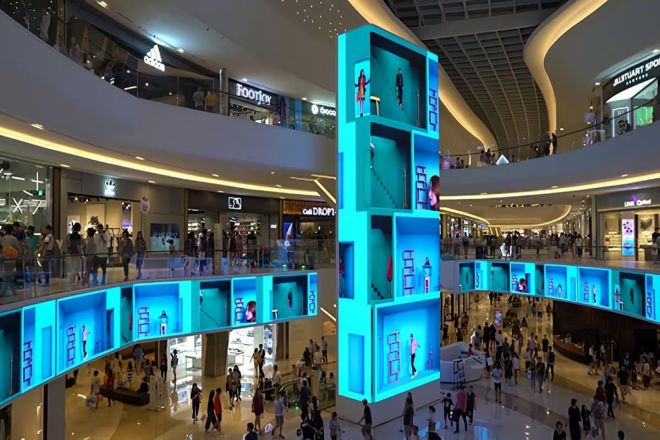
LED display screens not only provide shopping malls with diverse information dissemination channels but also greatly enrich customers’ shopping experience.
However, although the application of LED displays in shopping malls has become quite common, how to further optimize their use experience so that they can better serve shopping malls and customers is still a topic worthy of in-depth discussion.
As a comprehensive commercial space that integrates shopping, dining, entertainment, and other functions, the shopping mall’s LED display experience directly affects customers’ consumption experience.
A high-quality LED display experience can not only enhance the overall image of the shopping mall but also attract more customers to stop and watch, thereby increasing the shopping mall’s passenger flow and sales.
1. Analysis of the current status of LED displays in shopping malls
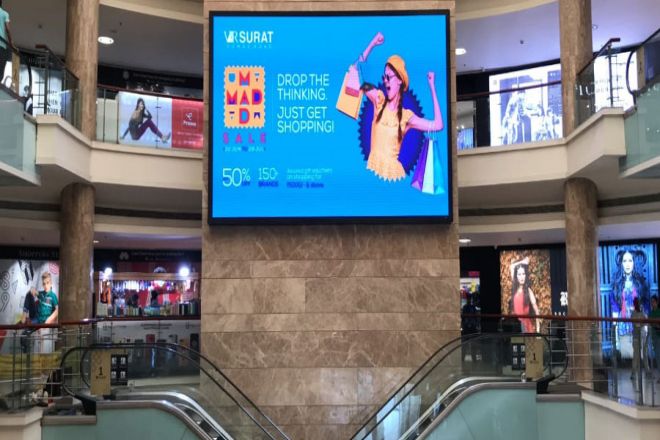
As a shopping mall manager, the first step in optimizing LED displays is to analyze the current situation of LED displays in shopping malls.
You can conduct a detailed inspection and evaluation from the following dimensions to gain a more comprehensive understanding of the current situation and provide a strong basis for subsequent optimization strategy development.
First of all, on-site observation is the most direct way to understand the current situation of LED displays. You can go to the mall in person and get a closer look at the display in action. Observations include, but are not limited to, the size, shape, location, installation angle, and whether there are signs of damage or aging on the display.
In addition, you also need to pay attention to the content played on the display screen, such as advertisements, event information, promotion tips, etc., and pay attention to the update frequency and diversity of the content.
Secondly, collecting customer feedback is an important part of evaluating the experience of using LED displays. Collect customers’ views and opinions on LED displays through well-designed questionnaires or face-to-face interviews.
The questionnaire can cover visual elements such as the clarity, brightness, and color performance of the display screen, as well as the attractiveness and interactivity of the content. Interviews can help you gain insights into your customers’ expectations and needs, as well as their suggestions for improving existing displays.
Next, analyzing technology applications is the key to understanding the current status of LED displays. You need to study the technical standards, hardware configuration, and software systems currently used in shopping mall LED displays.
Understand the key technical indicators such as resolution, refresh rate, and color depth of the display screen, as well as whether it supports advanced technologies such as dynamic image processing and intelligent control.
At the same time, attention should also be paid to the energy consumption and environmental protection performance of the display screen to evaluate whether it meets the current energy conservation and environmental protection requirements.
In addition, examining content production and broadcast strategies is also an important aspect of analyzing the current situation. Analyze the content type, production quality, and playback strategy of LED display screens in shopping malls. Find out if the content is diverse, creative, and engaging and incorporates the mall’s features and activities.
At the same time, the playback strategy should be evaluated to determine whether it is reasonable and make targeted adjustments according to time, place, and occasion, for example, during holidays or promotions, whether the frequency and duration of the corresponding content playback are increased.
Finally, horizontal comparison can help you understand the current situation of LED displays in shopping malls more comprehensively. You can compare shopping mall LED displays with displays in other commercial venues or in the same industry.
The comparison content can include technology applications, content production, broadcast strategies, etc. By comparison, you can discover where displays in other locations do better and what successes you can learn from or problems you can avoid.
2. How does LED display improve the shopping experience of mall customers?
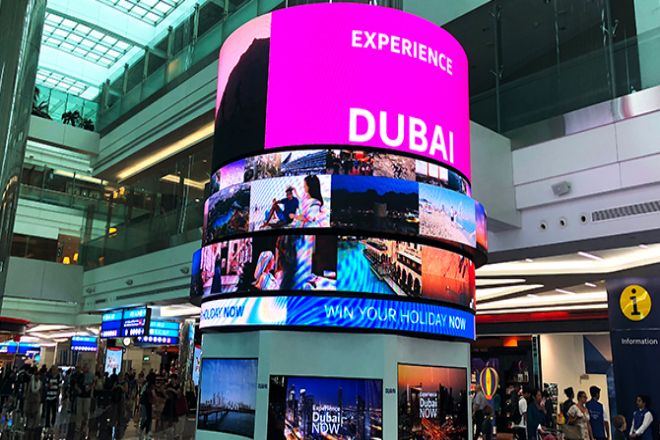
LED displays play an important role in shopping malls, not only conveying information but also improving customers’ shopping experience. In order to further optimize the experience of using LED displays, shopping malls can adopt the following strategies:
1). Improve visual appeal
High-definition picture quality and bright colors: Choose a high-resolution LED display to ensure clear and detailed playback content. At the same time, bright colors are used to attract customers’ attention and improve the communication effect of information.
Dynamic content and creative design: Regularly update the playback content to avoid playing the same picture for a long time. Combined with the characteristics of the mall, design creative playback content, such as animations, short videos, etc., to attract customers’ attention.
2). Enhance interactivity and personalization.
Touch screen and interactive games: Set up a touch screen next to the LED display so that customers can actively participate in interactive games, query product information, etc. Increase customer participation and stickiness through interactive experiences.
Personalized recommendation and customized services: We recommend personalized products and services to customers based on their shopping history, preferences, and other information. At the same time, customized playback content is provided to meet the needs of different customers.
3). Optimize playback strategy
Reasonably plan the playback time: According to the shopping mall’s business hours and customers’ shopping habits, reasonably plan the playback time of the LED display. Avoid playing too noisy or dazzling images during peak customer periods to avoid affecting customers’ shopping experience.
Zoned playback and directional guidance: Set up different playback areas according to the layout of the mall and product classification. According to the needs of customers in different areas, play corresponding product information and promotional activities to guide customers to the target area.
5). Strengthen maintenance and management.
Regular cleaning and inspection: Clean and inspect the LED display screen regularly to ensure that there is no dust, stains, etc., on the screen surface. At the same time, check whether the hardware equipment of the display screen is running normally, and if there is any problem, repair or replace it in time.
Software updates and security protection: Regularly update the software system of the LED display to obtain the latest functions and performance optimization. At the same time, network security protection is strengthened to prevent hacker attacks or malware intrusions.
3. What is the best placement strategy for LED displays in shopping malls?
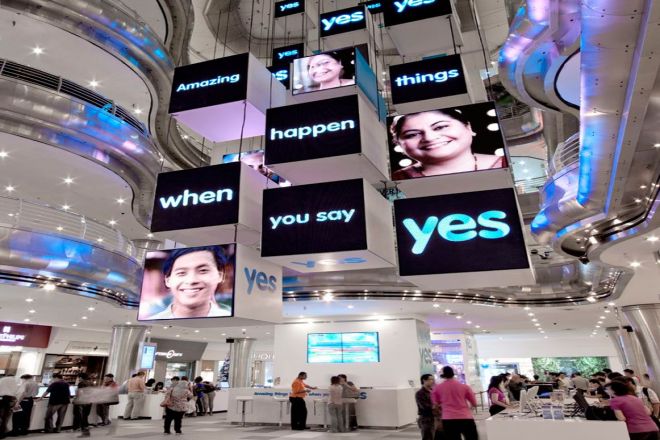
The optimal placement strategy for LED displays in shopping malls requires consideration of multiple factors to ensure they maximize their role in conveying information and attracting customers. Here are some key placement strategies:
High-traffic areas: Place LED displays in shopping malls in areas with high traffic volume, such as main passages, escalator entrances, rest areas, etc., to ensure that more customers can access the information on the display.
Brand area and store entrance: Placing LED displays in brand areas or near store entrances can help convey brand information and attract customers to enter the store to learn more about products or services.
Visual focus: Place the display at the customer’s visual focus position, such as at a height visible when looking up, to avoid being too low or too high, causing customers to ignore it. At the same time, the orientation and angle of the display should be considered to ensure that the information can be clearly seen by customers.
Interactive experience area: Set up an interactive experience area in the shopping mall and use LED displays as part of the interactive experience, such as with touch screens or interactive games, to increase customer participation and stickiness.
Navigation and guidance: Place LED displays at key nodes of the shopping mall, such as floor transitions, near service desks, etc., as navigation guides to help customers quickly find the target store or area.
Beautify the environment: In addition to conveying information, LED displays can also be used as part of the beautification of the shopping mall. Choose a display screen appearance and design that coordinates with the overall style of the shopping mall to enhance the image and quality of the shopping mall.
4. How do you choose appropriate content for shopping mall LED displays to attract customers?
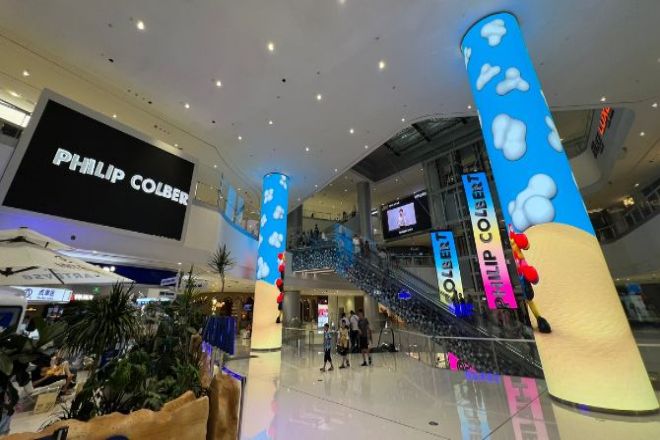
When choosing appropriate content to attract customers, shopping mall LED displays need to consider multiple aspects to ensure effective communication of information and active participation of customers. Here are some suggestions:
First, the content should be consistent with the mall’s positioning and brand image. The content of the shopping mall LED display should reflect the overall positioning and brand image of the shopping mall.
Whether it is high-end luxury or affordable and affordable, the content should be consistent with it to strengthen the brand image.
Secondly, the content should be timely and fresh. Update content regularly to ensure the information presented is up to date and avoid outdated or duplicate content.
At the same time, try to introduce novel and interesting elements, such as holiday themes, hot topics, etc., to attract customers’ attention.
Additionally, it utilizes dynamic images and visual effects. One of the characteristics of LED display screens is that they can display dynamic images and rich visual effects. Using this feature, you can create lively and interesting animations, short videos, or image carousels to attract customers’ attention.
At the same time, incorporate interactive elements. Consider adding interactive elements to the content, such as touch screen interaction, scanning QR codes to participate in activities, etc., so that customers can actively participate and increase the fun and experience of shopping.
Also, focus on the clarity and readability of the information. While it’s important to pursue visuals, clarity, and readability of information cannot be ignored. Make sure your text is a good size and has contrasting colors so customers can easily read and understand it.
Finally, consider your target customer segments. Adjust the content style and presentation method according to the mall’s target customer groups. For example, if the target customers are young people, the content can be more fashionable and lively; if the target customers are housewives, the content can be more practical and warm.
Conclusion
In general, optimizing the user experience of LED displays in shopping malls is a continuous and necessary process that involves technology upgrades, content innovation, strategic adjustments, and other aspects.
By continuously improving display effects, enriching content formats, optimizing playback strategies, and improving device performance, you can create a more attractive, interactive, and accurate shopping environment for customers.
Finally, if you want to know more about LED displays, please get in touch with us.
